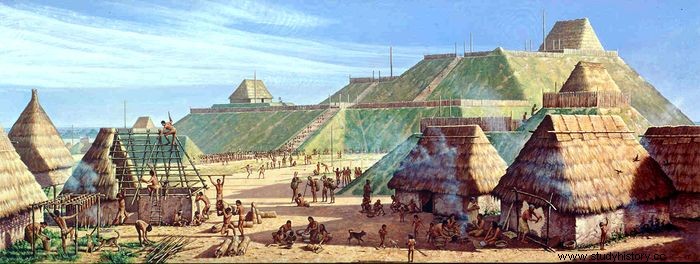Cahokia Mounds , archaeological site covering an area of 13 square kilometers in the Mississippi Au across from St. Louis, Missouri near Cahokia and Collinsville to the southwest of Illinois , United States. The site originally consisted of about 120 mounds spread over 6 square miles (16 km²), but some of the mounds and other ancient features have been destroyed. About 70 hills are preserved in Cahokia Mounds State Historic Site . The company founded in 1979 with a Area of 8.9 square kilometers became UNESCO declared World Heritage Site in 1982.
Cahokia was first 700 n . Chr . Busy and flourished for about four centuries ( approx. 950–1350). It reached a peak population of up to 20,000 individuals and was the most extensive urban center in the prehistoric America north of Mexico and the main center of the Culture of the middle Mississippi . The area later became Cahokia (meaning "wild geese") for a group of Illinois called peoples who inhabited the area in the 18th century.
For the design, construction and maintenance of the site, qualified administrators and a large number of Manpower required. It was laid out with clearly defined zones for administrative and ceremonial functions, elite Connections , residential areas, and even suburbs—all with similar alignments to the four cardinal points. Among its greatest features are a vast central plaza covering almost 16 hectares and numerous immense earthworks, including the pyramid Monks Mound (built between 900 and 1200), the largest prehistoric earthen structure in the western hemisphere , which rises to 30 meters, covers more than 6 hectares and contains more than 700 million cubic feet of earth. Monks Mound, the seat of government of Cahokia, is believed to have housed a building about 100 feet long, nearly 15 meters wide, and 50 feet high. Materials unearthed at the site indicate that the city was inhabited with people from the Gulf of Mexico , the Appalachia, the Great Lakes and the Rocky Mountains Traded .
Although there were some specialists in Cahokia society, most members were involved in agriculture, with Corn was the focus. The city was conveniently located on a major tributary of the Mississippi. Nearby were diverse Habitats, including open water bodies and swamps, that provided fish, the main source of protein for the population. Most importantly, the largest zone of high quality soils in the region was immediately to the east. There, in the floodplain and along the adjacent alluvial fans, were large fields of corn. Within the city itself, multicultural fields and home gardens were located on soils enriched by previous human occupation. While this mixed farming strategy was successful for dispersed populations in the region, it ultimately proved unsuitable for the much denser population of Cahokia.
The site and its hinterland declined and were eventually abandoned, likely due to environmental degradation , although it was suspected that disease, Climate change , societal stress and warfare may have been factors. The population made significant demands on wood resources for fuel and construction, and cleared the forests upstream from the site during the first centuries of the city's occupation. The denuded watershed resulted in greatly increased runoff, erosion, and unusual summer flooding rates in Cahokia's fields, resulting in crop failure and a decline in overall production. The economic and social consequences were catastrophic, likely leading to starvation, loss of confidence in leadership, increased competition for land, and regional warfare. During this period, the inhabitants went to great lengths to erect a series of palisaded wooden fortifications - clear evidence of external threats that had not previously existed. The city has been abandoned, from other Native American groups assimilates .

Archaeologists have studied Cahokia since the late 19th century, but only a tiny percentage of the site has been excavated. Researchers have attempted to determine when and for what purpose each mound was built, how and when the elite and common neighborhoods were established, how the different classes (e.g. workers , Artisans, and Elites) interacted and how Cahokia interacted with its hinterland. including its suburbs. They also tried the number of people who lived in Cahokia (estimates range from a high of 8,000 to 40,000) and the occupational Composition to determine of society. An on-site interpretive center includes a newly created village and information about the location. Conservation efforts have focused on acquiring more hill lands for the State Historic Site and addressing hill erosion, particularly the catastrophic hillside failures that have occurred on the East and West Coast since the mid-1980s west side of Monks Mound.


